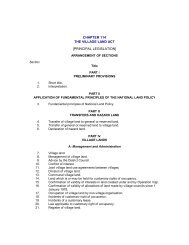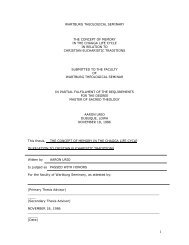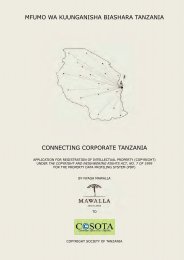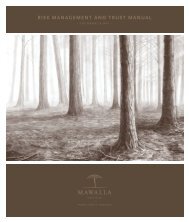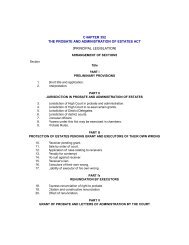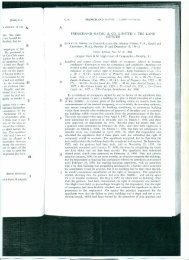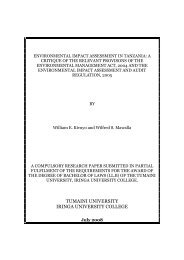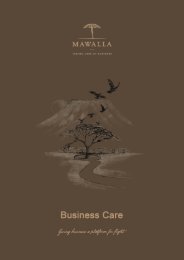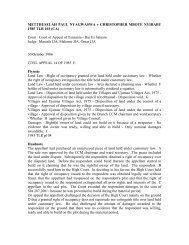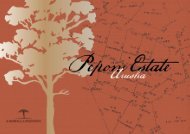MULBADAW VILLAGE COUNCIL AND 67 OTHERS v NATIONAL ...
MULBADAW VILLAGE COUNCIL AND 67 OTHERS v NATIONAL ...
MULBADAW VILLAGE COUNCIL AND 67 OTHERS v NATIONAL ...
Create successful ePaper yourself
Turn your PDF publications into a flip-book with our unique Google optimized e-Paper software.
<strong>MULBADAW</strong> <strong>VILLAGE</strong> <strong>COUNCIL</strong> <strong>AND</strong> <strong>67</strong> <strong>OTHERS</strong> v <strong>NATIONAL</strong>AGRICULTURAL <strong>AND</strong> FOOD CORPORATION 1984 TLR 15 (HC)Court High Court of Tanzania - ArushaJudge D'Souza Ag JDecember 3, 1984[zFNz]FlynoteE Land Law - Acquisition of land under the Land Acquisition Act, (No. 47 of 19<strong>67</strong>) -Procedure to be followed.F Land Law - Acquisition of land under the Land Acquisition Act (No. 47 of 19<strong>67</strong>) -Whether Act applies to the land belonging to peasants.Land Law - Right of Occupancy - Whether land held under customary tenure falls underthe definition of G right of occupancy - Whether authorities can grant a formal right ofoccupancy in respect of Land held under customary tenure, i.e. deemed right ofoccupancy.[zHNz]HeadnoteH The plaintiffs, a village council and <strong>67</strong> villagers of the same village sued the NationalAgricultural and Food Corporation (NAFCO) for a large tract of land in Hanang District,damages for trespass and other related reliefs. Detailed facts of the suit appear in thejudgment.I Held: (i) The Land Acquisition Act No. 47 of 19<strong>67</strong> applies also to land held undercustomary tenure;(ii) the definition of rights of occupancy under the land1984 TLR p16D'SOUZA Ag JOrdinance Cap. 113 and Act 47/19<strong>67</strong> includes titles of peasants holding land undercustomary A tenure;(iii) The Mulbadaw Village council and Mulbadaw Villagers were lawfullypossessing land and they could only be deprived of their land by due operation of Law,not by mere blessings of the government and party leaders in Hanang District and ArushaRegion; B(iv) the provisions of the Land Acquisition Act (No. 47 of 19<strong>67</strong>) were notfollowed in acquiring land belonging to Mulbadaw Village Council and MulbadawVillagers and therefore such acquisition was unlawful; C(v) where someone is in lawful occupation of land no valid right of occupancy canbe offered to anyone else over the same land unless the provisions of the LandAcquisition Act (No. 47 of 19<strong>67</strong>) have been complied with.[zCIz]Case InformationOrder accordingly. DNo case referred to.Musei for plaintiffsJundu for the defendant E
Editorial Note: National Agricultural and Food Corporation successfully appealed to theCourt of Appeal against this decision in Civil Appeal No. 3 of 1985 (to appear in 1986T.L.R). F[zJDz]JudgmentD'Souza Ag. J.: In this suit Mulbadaw village council, registered under the Villages andUjamaa Villages (Registration) Act 1975 and sixty seven villagers of the same village, intheir individual capacity are suing the National Agricultural and Food Corporation(hereinafter referred to as G NAFCO) for a large tract of land in Hanang District,damages for trespass and other connected reliefs. Originally the first plaintiff was statedas Mulbadaw village. On 24th of October 1981 in ruling on a preliminary matter ChuwaJ. allowed an amendment of the plaint to put the Mulbadaw village H council properlyon record. The land itself in dispute is 6095 acres of pasture land and 200 acres of arableland claimed by the first plaintiff as its property and another 1839 acres of arable landclaimed as theirs by the rest of the plaintiffs.At the beginning of the trial the following issues were agreed on by the parties andadopted as issue I in the case.1984 TLR p17D'SOUZA Ag JA (1) Was the 1st plaintiff owner of 200 acres of farming land and 6,195 acres ofpasture land at Mulbadaw village?(2) Were the 2nd to <strong>67</strong>th plaintiffs lawful owners of 1,830 acres of land atMulbadaw and did the defendant B occupy 3000 acres of land belonging to the plaintiffsand destroy three houses belonging to the 8th, 66th and <strong>67</strong>th plaintiffs?(4) In March 1980 did the defendant occupy another 3000 acres of landbelonging to the plaintiffs and destroy six houses belonging to 41st, 46th, 54th, 57th, 58thand 61st plaintiffs?C (5) In December 1980 did the defendant set on fire and destroy twenty fourhomesteads belonging to 3rd, 4th, 5th, 10th, 11th, 14th, 15th, 16th, 17th, 19th, 22nd,24th, 33rd, 35th, 36th, 43rd, 44th, 45th, 48th, 49th, 50th, 55th, and 62nd plaintiffs; anddestroy in these houses stored crops valued at Shs. 4,800 and also destroy 4281/2 acres ofgrowing maize and beans?D (6) If the defendant did the actions in issues 3, 4 and 5 above, were their actionslawful?(7) What reliefs, if any, are the parties entitled to?E In the defendant's written statement of defence the defendant raised an issue that theplaintiffs had no mandate from the Mulbadaw village council to institute the suit. At thetime of framing the issues this was not raised as one of the issues but defendant's counselcross-examined the plaintiffs' witnesses on it and again raised it in submissions at the endof the case. Counsel for the F defendant also went on to argue that only a few of the <strong>67</strong>villagers gave evidence and as the few had no authority to appear on behalf of the othersthe claims of those who did not testify ought to be dismissed. Although these argumentswere not framed as issues at the beginning they are issues G apparent from thepleadings, the evidence on record and the submissions of both counsel. Under Order XIVrule 5(1) I propose to deal with these as additional issues.The defendant does not deny that the Mulbadaw village is a registered village under theVillages and Ujamaa Villages Act 1975. PW4 Jonas Samu is the Chairman of the village
council. As such he H would be the natural and legal spokesman and representative ofthe village council. He was not cross-examined on the issue of mandate and hisstatement, in answer to a question from the court, to the effect that the village council hadauthorised the filing of the suit stands unchallenged. PW3 I Mohamed Abdi was amember of Mulbadaw village council until the end of 1981. The defendant tried to showthat he was not resident in the village. However he had land1984 TLR p18D'SOUZA Ag Jin the village and the villagers accepted him as a member of the council. PW3's evidencethat he was A a resident of Mulbadaw until events forced him to move in 1981 wassupported by the evidence of PW1 Frederick Tluway the Katibu Kata (Ward Secretary)of Bosanta in 1974. We stated that PW3 Mohamed Abdi was resident in Mulbadaw evenbefore May 1974. Counsel for the defendant has B brought to the attention of this courtthe evidence of DW6 Andrew Dally, DW9 Sebastian Gidamashghu, DW3 Joseph Kamilito the effect that Mohamed Abdi was a resident of Endasak and not Mulbadaw. On thisissue I believe I have to take the evidence of the defence witnesses with a grain of salt.The evidence of DW4 Karoli Flavian, taken together with Exhibit D.18 shows that CMohamed Abdi had an old house and mature trees around this house. DW 7 M.A.O.Mwengamba, probably in an unguarded moment, stated, "After this (The meeting of25.7.79) many villagers moved out but a few objected - e.g. Mohamed Abdi, HassanAbdi, Ami Habiye .." I also note that when the D plaintiffs filed their amended plaintthey also filed a document authorizing their counsel Mr. F.K. Musei to sign the plaint ontheir behalf and authorizing the plaintiffs Welwel, Mohamed Abdi, Ami, Yusuf andBangi to represent them in the suit. On these preliminary issues I therefore find in favourof the plaintiffs. EIn this case although the issues, for purposes of convenience were split into six, there isone central issue that is paramount and on which the entire decision will necessarily rest.This issue arises from paragraphs 4 to 6 of the written statement of defence. Thedefendant does not deny that it entered into and still occupies land at Mulbadaw. It pleadshowever that it has been carrying out a lawful F Tanzanian national project, theMulbadaw wheat project, covering 10,000 acres - part of the Hanang Wheat Complexcovering 70,000 acres under the Canada - Tanzania Wheat Programme- the area havingbeen identified by the Government for that purpose. In paragraph 5 of the writtenstatement G of defence the defendant states that in order to give way to the said nationalproject the Government and Party (C.C.M) authorities had more than once ordered andnotified Mulbadaw villagers to vacate the areas identified for the project. In paragraph 6the defendant asserts that since H identification of the area for the project by thegovernment the defendant has maintained a lawful occupation of the land as pergovernment directives.During the course of the hearing of this case the defendant added another fact to itsdefence. Although the defendant did not apply to amend the written statement of defenceI find that both I1984 TLR p19D'SOUZA Ag JA parties led evidence and cross examined on this aspect and I find that in order to dojustice between the parties and to sort out the real issues in controversy between them it is
necessary to make a decision on this aspect too. This is to the effect that NAFCO has alawful right of occupancy over the disputed areas.B Before coming to the decision on the issues, let us consider the defendant's evidenceon them. DW.1 Sadiki Omar Libembembe, an Administrative Officer with NAFCOtestified that in 1960 the Government started research into the possibilities of large scalegrowing of wheat in Hanang C District. He produced as exhibit D.1 a Plan made by theBritish Government's department of surveys and issued by the Ministry of Land andHousing. He stated that in 1969 the Kilimo Department started Bassotu Wheat Schemeand in the same year NAFCO was established by Act 17 of 1969. He D produced photocopies of the national development plans showing that the wheat projects in Hanang werepart and parcel of national development plans. On the question of how the projects wereimplemented vis-a-vis the peasants already in occupation of land in the marked areas hesaid this:E When we start a project the peasants are informed through the instruments of theGovernment and the Party. A letter is written from NAFCO Headquarters to the RegionalParty Secretary who was then also the F Regional Commissioner. He then spreads themessage to the villagers through the Katibu Kata, etc. The NAFCO Manager in the areaalso assists in the spread of the informationDW7 MAO Mwengamba, Manager of Mulbdaw wheat project, on this aspect had this tosay:G In the 1980/81 season we had to move people out. The procedure followed was toinform the Katibu Kata of the affected area. On 29.3.1979 I saw the Katibu Kata toinform him to move out the peasants who were in the area earmarked for expansion.H This witness went on to explain how NAFCO Officers held a meeting on 25.7.79 withthe Mulbadaw village authorities who were accordingly informed of the boundaries ofMulbadaw farm.I On the second facet of the defendant's defence a number of witnesses testified - themain one being one T.M. Hyera (DW2) of the Land Office at Arusha. According to thiswitness an application1984 TLR p20D'SOUZA Ag Jby NAFCO for 22,793 acres of land at Bassetu was approved by the Regional LandAdvisory A Committee and by its letter AR/R/1009/22 of 20.1.1973 to NAFCO theLand Office made a formal "offer" of a right of occupancy. There is no evidence onrecord that this offer of 20.1.73 was accepted and registered. Instead there is a request fora resurvey and division and new offers for smaller units. Accordingly another offer (Ex.D.16) was issued to NAFCO for the Mulbadaw area - B dated 29.7.1981. The same wasaccepted and fees were paid in August 1981. The offer document was signed by NAFCOin July 1981. The Right of Occupancy was for 99 years back-dated to 1.7.1979. CAt the end of the case for both sides the court specifically directed both counsel to submiton the applicability of Act 47/19<strong>67</strong> Land Acquisition Act. Both counsel, Mr. Jundu andMr Musei did so. Section 3 of the said Act authorizes the President to acquire land wheresuch land is required for any public purpose. S.4(2) provides: DWhere the President is satisfied that a corporation requires any land for thepurpose of construction of any work which in his opinion would be of public utility or inthe public interest or in the interest of the national economy, he may, with the approval,
to be signified by resolution, of the National Assembly and by order E published in thegazette, declare the purpose for which such land is required to be a public purpose andupon such order being made such purpose shall be deemed to be a public purpose for thepurpose of this Act. FSection 6 of the same Act provides that if the President resolves that any land is requiredfor a public purpose the Minister (for lands) shall give notice of such intention to thepersons interested or claiming to be interested in such land. Section 7 provides that theMinister may provide by notice G under s.6 or subsequent notice directing the personconcerned to give up possession within a specified period not less than six weeks fromthe date of publication of such notice in the gazette. The President may, in urgent cases,certify so and possession may be obtained in a lesser period. Section 8 provided for themode of publication of the notices. HCounsel for the defendant has argued that the Act is not applicable to land held bypeasants under customary land tenure and only applies to formal rights of occupancy.This court is unable to agree. The definition of right of occupancy under Cap. 113 of theLand Ordinance and Act 47/<strong>67</strong> includes I titles of peasants holding1984 TLR p21D'SOUZA Ag JA land under customary tenure. Furthermore s.17 of the Land Acquisition Act providesthat where any question arises respecting title to any land the party in possession shall bedeemed to be lawfully entitled to such land unless the contrary is shown to thesatisfaction of the court. In this B matter if the plaintiffs (including 1st plaintiff) were inpossession of the disputed land before NAFCO came on the scene they would be deemedto be entitled thereto.In view of the above it appears that the law and procedure to be followed in acquiringland for public purposes is clear enough. It is also clear from the evidence of the defencewitnesses that the law, C though clear, was not followed. However whether theprovisions of the Land Acquisition Act can be applied to the facts of this case woulddepend on this court's decision on issue No. 1 and 2 as framed.On issue No.1 PW.1 Frederick Tluway, the then Katibu Kata of Bassotu Ward, testifiedthat from D may 1974 to September 1975 he was one of those involved in theestablishment of village under "operation vijiji". Mulbadaw was one of the villagesestablished. On the western side its boundary was Bassotu Plantations and Bassotu Lake.On the Eastern side its boundary was the Rift Valley E escarpment. On the Northernside it bordered on the Rift Valley and Ufana Ward in Bashnet. On the south side, theLaq'ang hill. According to this witness these boundaries followed the old boundaries ofwhat was even then called Mulbadaw village. The land within the village was dividedinto areas for housing, farming areas for cultivation and pastures. According to theevidence of PW3 F Mohamed Guled Mulbadaw village was registered and incorporatedunder reference Reg. AR/KIJ/266 as per exhibits P.2 and P.3. There was also theevidence of PW.4 Jonas Samu on this issue that Mulbadaw developed into a fully fledgedvillage with 'kayas' and a council. The G defendant has argued that as the village wasnot registered until 1976 it could not hold land in 1975. I accept the evidence of PW.1Frederick Tluway. The effect of this evidence is that before the village was incorporatedMulbadaw village was an administrative unit. When it was incorporated it was in Hpossession and control of all land within the former administrative unit. It is
inconceivable that a village was registered or incorporated without any land in itspossession and control. Although the first issue was framed based on 'ownership' I findthat once the village council the 1st plaintiff establishes lawful possession, it hasestablished the preliminary requirement for a suit in trespass to I land. In view of this Ido not consider it necessary to consider the defendant's argument that Mulbadaw villagecouncil had no formal right of occupancy1984 TLR p22D'SOUZA Ag Jover the land within the boundaries given by PW1. Frederick Tluway. I am satisfied thatthe village A council were in lawful possession and control of the land in question. Thefirst issue is accordingly answered in the positive and in favour of the 1st plaintiff.On issue No.2 relating to 2nd to <strong>67</strong>th plaintiffs the following evidence is relevant. PW1Frederick Tluway when he supervised "Operation vijiji" in Mulbadaw in 1975 foundpeasants already in B occupation of the area of Mulbadaw. He did not find NAFCO inthe area which they set aside for Mulbadaw village which was later registered andincorporated. Of these he remembered the second and the 54th plaintiffs. We also havethe evidence of PW.2 Welwel, PW 3 Mohamed Abdi, PW 4 C Jonas Sama, PW5Habiye, PW6 Yusuf Ally and PW 7 Bangi Laida that they or other peasants were inoccupation for a long time before NAFCO moved into the area. DW1 Sadic OmarLibembembe and DW7 MAO Mwingamba in their evidence also admitted that in 1978when NAFCO moved into D Mulbadaw area they found peasants living in the area.However Exhibit P.6, minutes of a meeting held by Mulbadaw village on 6/1/81contained a list of peasants whose crops were destroyed. The list gives the destroyedacreage of each peasant. According to PW3 Mohamed Guled on 6/1/81 the meetingelected a committee to deal with their problems. They visited the farm of each peasant Eaffected and recorded the damage done. Later in his evidence PW3 Mohamed Guledstated that the list was of <strong>67</strong> people who had their houses or crops destroyed. PW3 wasnot cross examined on the correctness or otherwise of this list. On the basis of theevidence of PW1 to 7, the admissions made F by DW.1 and DW7 and on the basis ofExhibit P.6 I find that the second to the <strong>67</strong>th plaintiffs were in occupation of 1,839 acresof arable land in Mulbadaw village before NAFCO started operations in the area underthe administrative jurisdiction of Mulbadaw village council. The village council Grecognised that their occupation was lawful and they had been in occupation for aconsiderable time before NAFCO decided to expand. They had customary tenancies orwhat are called deemed rights of occupancy.The defendant does not allege that it entered into vacant land. On the contrary it statesthat it H rightfully displaced the village council and the peasants after the land was'identified' for its use - in other words the rights of the peasants and the village councilwere extinguished or gave way to the superior rights of NAFCO. The court finds therights of the peasants and the village council could not be extinguished or supersededexcept by due operation of law. I1984 TLR p23D'SOUZA Ag JA In view of the above issue No.2 is also answered in favour of the plaintiffs.This court proposes to consider the evidence on issues 3, 4, 5, and 6 jointly as theyoverlap considerably. However the same can be considered in two parts. Firstly whether
NAFCO unlawfully B entered into the land (found in issues No.1 and 2 to be owned byor at least in the lawful occupation of the plaintiffs). The second part is whether housesand crops were destroyed as alleged.The Defendant contends that it entered the land lawfully with the blessings ofgovernment and C party leaders in Hanang District and Arusha Region. It is possiblethat the leaders concerned were acting in good faith but enthusiasm in implementingnational projects should not encourage the taking of short cuts. The Mulbadaw villagecouncil and Mulbadaw villagers could only be deprived of their land by due operation oflaw. The Land Acquisition Act 47/<strong>67</strong> provides the law on theD matter. The same Act alsoenvisages situations where land is needed urgently and those in possession can bedispossessed at an enhanced speed. But as already held elsewhere in this judgment theprovisions of this law were not followed.E The Defendant also contends that the land it occupied was land in respect of which itheld a valid right of occupancy. The Defendant produced three offers of rights ofoccupancy as exhibit D.10, D.11 and D.16. There are two reasons why this aspect of theDefendant's defence cannot stand. Firstly where someone is in lawful occupation of landno valid right of occupancy can be offered to F anyone else over the same land unlessthe provisions of the Land Acquisition Act 47/<strong>67</strong> have been complied with. To holdotherwise would mean the Commissioner for Lands, by simple device of making offers ofrights of occupancy could bypass the provisions of the law. In view of this I hold G thatthe right of occupancy offered to NAFCO in respect of Mulbadaw wheat project was notvalid. Secondly the offers as per Exhibits D.10 and D.11 were never formally accepted.The offer for Mulbadaw Wheat Project (Ex-D.16) was accepted in July 1981 and therequisite fees paid in August 1981. This was well after NAFCO had evicted the plaintiffsfrom the land. In other words when H NAFCO set out to expand into Mulbadaw theydid not even have a right of occupancy over the area. For the above reasons this courtfinds that NAFCO's entry into the 8,125 acres in dispute in this case was illegal.On the second aspect of these issues the Defendant has denied destroying 33 housesbelonging to I 8th, 66th, <strong>67</strong>th, 3rd, 4th, 5th, 10th, 11th, 14th, 15th, 16th, 17th, 19th,22nd, 24th, 33rd, 35th,1984 TLR p24D'SOUZA Ag J36th, 43rd, 44th, 45th, 48th, 49th, 50th, 55th, 62nd, 41st, 46th, 54th, 57th, 58th, and 61stplaintiffs. The A defendant also denied destroying stored grain worth Shs. 4,800/- and4281/2 acres of growing maize and beans. On the destroyed houses the defendant appearsto state that the peasants voluntarily demolished them. On the stored grain the defendantdenied any knowledge of the same. B On the destruction of crops the defendant admitsthat these were destroyed but states that this was not done by it. In paragraph 4 of thewritten statement of defence the defendant states that no trespass, blazing of houses andunlawful up rooting of crops had been committed by him (sic) at any point of time but allalong since 1978 to present day the defendant has been carrying on a lawful C Tanzanianational project.Let us look at the evidence on this aspect. DW.3 Joseph Kamili was the officer in chargeof the police station at Bassotu at all relevant times. He said that while holding that posthe had never D received any complaints from peasants in Mulbadaw that NAFCO hadburnt down or demolished their houses and destroyed their crops. In the same breath he
stated that on 17.10.80 he was chosen as a member of sub-committee appointed by theBassotu Ward Authorities to look into complaints E from peasants who said their houseshad been burnt down. According to this witness when the subcommittee of six visited theareas they only saw some "bomas" or cattle enclosures burnt down. When crossexaminedby Mr. Musei for the plaintiffs he said that he did receive complaints from thepeasants that their houses were burnt down. He found some houses demolished by thepeasants F themselves. D.N. 5 Amos Mwita was in the uncomfortable position of beingthe officer in charge of law and order in Hanang District at the relevant time. He said hedid not personally receive any complaints from the peasants that their crops and houseshad been demolished or destroyed - he G received these from the "O.C.S." Bassotu andthe Area Commissioner of Hanang District. He received this news by radio call on8.12.80. He made an investigation and wrote a report (Exhibit D.19) to the AreaCommissioner. The relevant part of the report reads: HMnamo tarehe 29/12/80 Mkuu wa Polisi Wilaya ya Hanang alifuatana na baadhiya walalamikaji walifika sehemu ya mahame yaliyosemwa kuchomwa. Hakuona dalili yanyumba au mazao kuchomwa ila kulikuwa na masalia ya majivu ya magogoyaliyong'olewa na kuchomwa. Kulikuwa na udongo I1984 TLR p25D'SOUZA Ag JA uliosukumwa na kurudishwa pamoja kwa kitu kama mashine. Walalamikaji ..walishindwa kuonyesha masalia.On cross-examination he said he saw the remains of some small maize plants that hadbeen ploughed B over. DW.7 MAO Mwangamba, the manager at Mulbadaw at therelevant time also gave similar evidence - that only cattle enclosures or fencessurrounding houses had been burnt and that houses had been moved by the peasantsthemselves. However to the script. He stated that from 3rd to 5th C January 1981 theKatibu Kata, the Mratibu Kata and the police from Bassotu came to Mulbadaw to ask foragricultural equipment to assist in moving out the peasants - tractors and plough. Onthese three days "the job" was, he said, done. In cross-examination he said that he gavethem four tractors driven by the drivers working for NAFCO - Mulbadaw and under hisdirections. He was D around on the first day of the "operation" and then left for Arusha.DW.10 Charles Kapera the 'O.C.S.' Bassotu in 1979, 1980 and 1981 also gave similarevidence. DW.9 Sebastian Gidamashghu, the Katibu Kata of Bassotu was also one of thepeople involved in the exercise of removing E peasants from the area. On the side of theplaintiffs on these issues we have the evidence of PW2 Welwel Amsi, PW 3 MohamedGuled, PW 6 Yusufu Ali, and PW 7 Bangi Laida. Welwel Amsi described the progressiveexpansion of the Mulbadaw project over 3 years and its effect on the plaintiffs. So didPW.3 Mohamed Guled, PW6 Yusuf Ali and PW7 Bangi Laid. In weighing the F relativecredibility of these witnesses on these issues I have taken into account that they must bequite bitter about losing their land, houses, and livelihood. However, I have, with this inmind observed that demeanour and reaction to cross-examination and I find them to betruthful witnesses. G I find that the evidence of DW.3 Joseph Kamili, DW.5 amosMwita, DW.7 Charles Kapera, all of whom were involved in various stages of removingthe peasants, their houses and crops from the disputed land, to be unreliable and selfserving.Aside from these opinions of this court on credibility I find that there arecircumstances lending support to the plaintiffs' case. DW.1 Said Omar H Libembembe




